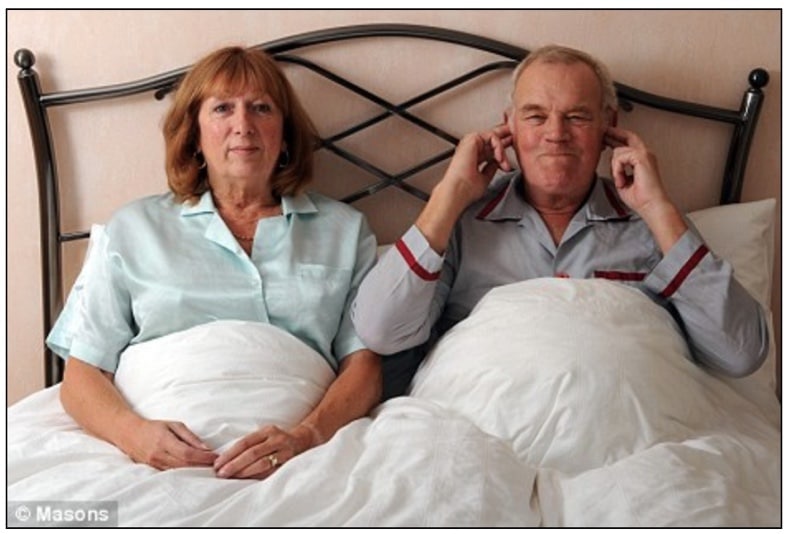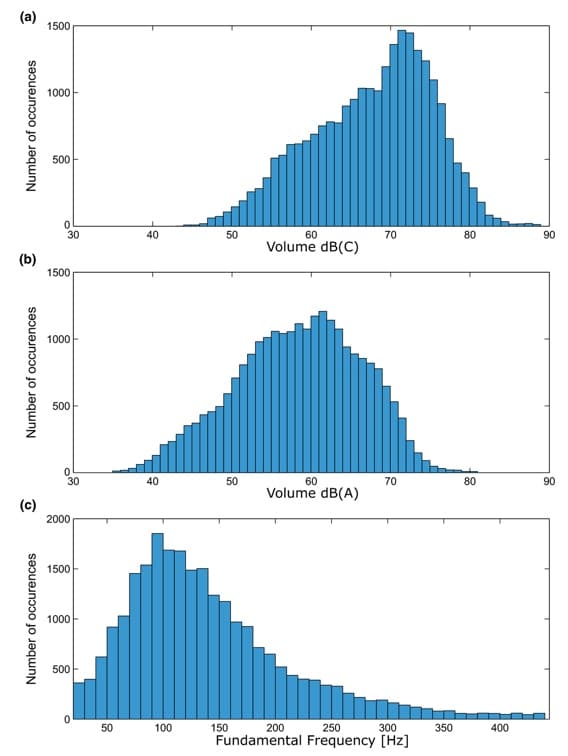More than 40 million adults in the U.S. snore, which is approximately 20% of the adult population. Men are reported to engage in habitual snoring at a rate of 45% versus 25% for women.1,2 An article in the Daily Mail of the United Kingdom reported that around 75% of the UK population are believed to be snorers with the condition most prevalent in middle-aged men3.
Grandmother snores at 111.6 dB Sound Pressure Level
Some individuals are known to be loud snorers, but this 60-year old grandmother takes snoring to a new level!

Figure 1. Jenny Chapman snores at 111.6 decibels – eight decibels louder than a low-flying jet – much to the dismay of her husband Colin. (Photo and legend from Daily Mail, October 15, 2009).
As impossible as it sounds, this is the level reported in an article in the Daily Mail in the United Kingdom in 2009 (Figure 1). The decibel (dB) level was measured at a snoring ‘boot camp’ from monitors on Mrs. Chapman’s pillow. The experts at the camp indicated this was the loudest they had ever experienced.3
In all fairness, Jenny’s snoring was not a constant level, but the very loudest peak measured. The peak level was 12.4 dB lower on a second night at 99.2 dB. Still, these are very high levels. Logical questions relate to how these levels were recorded, but no information was found, other than “monitors on the pillow.” Obviously, the closer to the source, the louder the measured level. For example, Killion et. al. made probe measurements of the sound pressure levels developed in the back of the mouth for the vowels EE, OO, and AH, and recorded levels of 142, 138, and 116 dB SPL for these vowels respectively.4
These levels are much different than the usual reported level of 65 dB for normal speech when measured at a distance from 3 feet. The point is that measurements must be made consistently in order to have meaning. A table later in this post compares the range of researched snoring levels in a typical population to the range of common sounds.
You will see that the Grandmother’s snoring levels are higher than the range reported, but it would have been necessary to have the measurement protocol identified so that a more reasonable comparison could be made to her snoring levels to other sounds without the sensationalism reported by the newspaper.
From the Atypical to the Typical
So, what would be typical levels, or the range of snoring levels, in a general population? Again, the measurement protocol must be identified. The fact that they often are not, makes it difficult to compare reported levels.
One study that established detailed information on how the loudness of snoring was recorded compared two different microphone locations – one placed on the middle of subjects’ chests, and two other microphones were located at a fixed distance of 95 cm above the bed with a 70-cm distance between microphones.5 The sound levels of the two overhead microphones was averaged for statistical analysis, but listened to in stereo for manual scoring of events. Ten adults served as test subjects.
Microphones used in this study had a sampling frequency of 8 kHz and calibrated with C-weighting. An illustration of the measurement setup is shown in Figure 2. According to the authors, they used the dB(C) weighting rather than the dB(A) weighting because the dB(A) weighting has been shown to underestimate subjective annoyance for frequencies under 100 Hz.6 Therefore, the authors considered dB(A) weighting to be an inappropriate measure for assessment of objective snore characteristics or partner complaints of snoring. However, for comparison with previous literature, snore levels were recorded in dB(A) as well.

Figure 2. Setup of the study with regard to snore sensors. The microphone sensor locations are circled in red. In this study, the two overhead microphone recorded sound pressure levels were compared with that at the chest.
Snore events had to have an audible oscillatory component. No dB threshold was used to qualify as a snore event. This depended upon the microphone used and the distance of the microphone from the snore sounds. All non-snore sounds were excluded (coughing, groaning, high-pitch squeaks, duvet noise, and large breathing sounds without vibration). Both inspiratory and expiratory snores were scored.
An entire night’s recordings of snoring (n=25,268 events) for the chest microphone, which provided the most consistent results, are shown in Figure 3. Figure 3a shows the dB(C) range, 3b shows the dB(A) range, and 3c shows the fundamental frequency range. On the dB(C) scale, the range of snore intensity was from about 45 dB to about 85 dB, with a mean of 67.7 dB. As expected, this range is different on the dB(A) scale, with a range of about 25 dB to about 75 dB, and a mean of 58.4 dB.
The mean sound level of all snore events measured on the subject’s chest was:
67.7 ± 7.6 dB(C) – Figure 3a
58.4 ± 7.9 dB(A) – Figure 3b
The fundamental frequency for snore events as measured in the chest audio was:
141.7 ± 75.6 Hz
Range: 20.0 – 444.0 HZ – Figure 3c.

Figure 3. The distribution of all events scored manually by listening to snore (n=25,268) for 10 subjects for an entire night’s recordings from the chest microphone: (a) the dB(C) range, (b) the dB(A) range, and (c) the fundamental frequency range.
Sleep Apnea Study
Another large study was conducted on a population of 1643 habitual snorers who were referred for sleep apnea.7 The information from the study of interest related to one of the secondary objectives of the study, specifically that of the intensity level of snoring. In this study, sound intensity was recorded using a CEL-231 Digital Sound Level Meter, CEL Instruments, Bedford, England.
Whether the subjects snored, and how loudly they snored was revealed in a self-answered questionnaire that all patients completed. The perceived loudness was rated from 1 (mild) to 4 (severe). Additionally, the maximum decibel level recorded on the sound level meter during each 30-second epoch of a synchronously recorded polysomnogram was identified, and the mean peak decibel (dB) level was used to determine snoring intensity.
Based on a previous validation study (unpublished) in the laboratory on a separate group of subjects, led to a classification of snoring as mild (40-50 dB SPL), moderate (50-60 dB SPL), and severe (>60 dB SPL).
Overall, men had louder snoring than women (54.1 ±6.4 dB SPL) versus 47.4 ±4 dB SPL). The study did not report any weighting of the sound level meter when making the intensity measurements, nor the specific location of the measurement microphone.
The following table compares snoring to a typical range of common sounds based on A-weighted sound pressure measurements in dB. A-weighting was used because the range of the common sounds were recorded using A-weighting.
Are Snoring Levels Loud Enough to Cause Hearing Loss?
The study by Maimon and Hanly7 commented on their study results as follows:
- It appears that bed partners are exposed to considerable environmental noise at night.
- The average sound intensity of their subjects’ snoring exceeded the limits of nocturnal environment noise pollution levels recommended by government agencies.
- In some patients, the peak sound intensity was above that considered necessary to avoid hearing loss.
- Their results supported recent studies which showed an association between sleep disordered breathing and the bed partner’s quality of life.
Does Loud Snoring Cause Hearing Loss?
We explore that in the next post
References
1. Young T, Palta M, Dempsey J, et al. The occurrence of sleep-disordered breathing among middle-aged adults. N Engl J Med. 1993;32:1230–5.
2. Ohayon MM, Guilleminault C, Priest RG, et al. Snoring and breathing pauses during sleep: telephone interview survey of a United Kingdom population sample. BMJ. 1997;314:860.
3. Meet the grandmother who snores at 111 decibels…louder than a JET plane. (2009). Daily Mail, October 15, 2009.
4. Killion, MC, Wilber LA, and Gudmundsen, GI. (1988). Zwislocki was right. Hearing Instruments, 39: 14-18.
5. Arnardottir ES, Isleifsson B, Agustsson JS, Sigurdsson GA, Sigurgunnarsdottir MO, Sigurdarson GT, Saevarsson G, Sveinbjarnarson AT, Hoskuldsson S, Gislason T. (2015). How to measure snoring? A comparison of the microphone, cannula and piezoelectric sensor. Journal of Sleep Research, Vol 25: 158-168.
6. Leventhall, H. G. Low frequency noise and annoyance. Noise Health, 2004, 6: 59–72.
7. Maimon, N., and Hanly, P.J. (2010). Does snoring intensity correlate with the severity of obstructive sleep apnea. J. Clinical Sleep Medicine. October, 15; 6(5): 475-478.
Wayne Staab, PhD, is an internationally recognized authority in hearing aids. As President of Dr. Wayne J. Staab and Associates, he is engaged in consulting, research, development, manufacturing, education, and marketing projects related to hearing. His professional career has included University teaching, hearing clinic work, hearing aid company management and sales, and extensive work with engineering in developing and bringing new technology and products to the discipline of hearing. This varied background allows him to couple manufacturing and business with the science of acoustics to bring innovative developments and insights to our discipline. Dr. Staab has authored numerous books, chapters, and articles related to hearing aids and their fitting, and is an internationally-requested presenter. He is a past President and past Executive Director of the American Auditory Society and a retired Fellow of the International Collegium of Rehabilitative Audiology.
**this piece has been updated for clarity. It originally published on November 21, 2017







